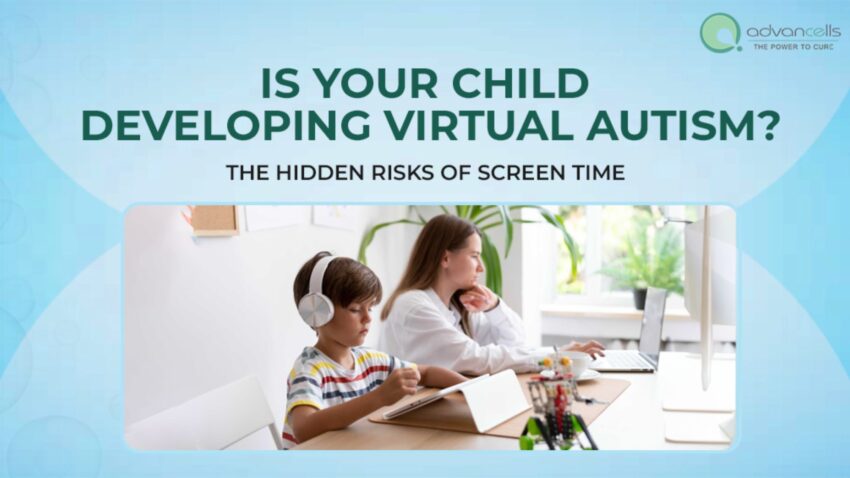Have you ever observed a change in your child’s behavior after excessive screen time? Perhaps they seem withdrawn or struggle to connect with others. These changes could be Signs of Virtual Autism, a term used to describe behaviors similar to autism spectrum disorder (ASD). In this Article, we will dive headfirst into the secrets of virtual autism, helping you spot signs and take action. Empower your child’s development—dive in and learn more!
What is Virtual Autism?
Virtual autism is an informal term that is used to describe the manifestation of autism spectrum disorder behaviors in children who are regularly exposed to prolonged virtual environments. These virtual environments can include watching videos, playing video games, and social media interaction, among others.
It is essential that we differentiate between virtual autism and Autism Spectrum Disorder, as the latter condition presents genuine challenges in social communication and interaction. Whereas, virtual autism refers to a condition that is induced by excessive engagement with the virtual environment.
Differences between Virtual Autism and Autism Spectrum Disorder
| Virtual Autism. | Autism Spectrum Disorder. | |
| Definition. | An informal term that refers to an overexposure to virtual stimuli, but is not a recognized medical or psychological diagnosis. | A complex neurodevelopmental disorder that is recognized by deficient in social communication, and repetitive behavior. |
| Recognized as a medical condition. | It has not been recognized as a legitimate neurodevelopmental condition. | It is recognized as a legitimate neurodevelopmental condition by WHO. |
| Diagnosis. | There is no established standardized diagnostic criteria available. | There is an extensive diagnostic criteria outlines in diagnostic manuals like ICD 10/11*. |
| Symptoms. | There are no standard or recognized symptoms. The symptoms used to recognize virtual autism include:• Excessive screen time• Social withdrawal• Changes in behavior | There are clear and well-defined symptoms, including difficulties in• social interactions and communication• repetitive behaviors• avoiding eye contact and pretend play |
| Demographics. | There is no data available for the condition and the concept itself is still under debate. | The most recent studies report that 1 in every 100 children suffers from autism. |
| Treatment. | No evidence based treatments are known. | Multidisciplinary therapies are available including occupational, speech, and behavioral therapy are used to help children with autism. In addition, alternative approaches like stem cell therapy are also increasingly being used for treatment. |
Virtual Autism Symptoms
As we mentioned above, there are no predefined Symptoms for Virtual Autism, However, we did mention that the children start to act similar to those children with autism. You can keep an eye out for the following symptoms following prolonged screen times, typically about 3 hours or more:
- Difficulties processing non-verbal social cues
- Avoiding eye contact
- Inability to use appropriate facial expressions
- Do not engage in conversations
- Show signs of aggression, irritability and impulsivity
- Difficulty following a sleep pattern
These telltale signs can be recognized as red flags for virtual autism. Once you see these signs in your child, you can take preventive steps to let your child grow to be a responsible part of society who is achieving their full potential. To do so, we first have to start with an evaluation, specifically, virtual autism evaluation.

Virtual Autism Evaluation
There isn’t a standardized test to diagnose “virtual autism” specifically, since it’s not a recognized medical condition. However, there are ways to assess a child’s screen time habits and potential impacts on their development:
1. Track Screen Time:
- Monitor how much time your child spends on screens (TV, tablets, phones) daily.
- Consider apps that track screen time or set time limits on devices.
2. Observe Social Interactions:
- Pay attention to how your child interacts with others during playtime.
- Do they initiate play?
- Do they share toys?
- Do they engage in back-and-forth conversation?
- Look for difficulties with eye contact, taking turns, or understanding non-verbal cues.
3. Assess Communication Skills:
- Do they use appropriate gestures and facial expressions?
- Is their speech clear and easy to understand?
- Are they able to follow simple instructions and answer questions?
4. Evaluate Play Patterns:
- Do they engage in pretend play with dolls or action figures?
- Do they build structures with blocks or create imaginative scenarios?
- Are they easily frustrated or withdrawn during playtime?
5. Monitor Emotional Regulation:
- Notice how your child manages their emotions.
- Do they have frequent meltdowns or tantrums, especially when screen time is limited?
- Can they calm themselves down or do they require adult intervention?
If you notice any delays in your child’s development, social skills, or communication, consult a pediatrician. They can conduct a comprehensive evaluation, including developmental screenings and potentially an autism assessment, to determine the root cause and recommend the best course of action.
Virtual Autism Recovery Signs
There are positive signs to look for if you’ve reduced your child’s screen time and are concerned about potential developmental delays. These signs indicate a return to healthier developmental patterns:
1. Increased Social Engagement:
- This is a hallmark of recovery. Look for your child initiating play with others, showing interest in social interactions, and participating more actively in family activities.
- Pay attention to eye contact during discussion, willingness to share toys, and attempts at back-and-forth communication.
2. Improved Communication Skills:
- Notice if your child’s verbal and non-verbal communication skills are progressing.
- Are they using more gestures and facial expressions to communicate?
- Is their speech clearer and easier to understand?
- Are they following instructions more readily and engaging in conversations?
3. Enhanced Play Patterns:
- Observe a shift towards more imaginative and interactive play.
- Look for pretend play with dolls or action figures, building structures with blocks, and creating storylines during playtime.
- A decrease in frustration or withdrawal during play is also a positive sign.
4. Decreased Screen Dependence:
- A crucial sign of recovery is a reduced insistence on screen time.
- Your child should be able to engage in other activities without significant distress or meltdowns.
5. Emotional Regulation:
- Notice if your child is managing their emotions more effectively.
- Are meltdowns or tantrums less frequent, especially when screen time is limited?
- Can they self-soothe or calm down with minimal adult intervention?
Conclusion
Virtual autism may not be officially recognized as a condition. It is essential to consider its potential impact, on a child’s growth. To support your child’s development focus on reducing screen time, promoting social interactions and seeking assistance when needed. Early intervention plays a vital role in guiding your child towards reaching their potential. If you have any concerns about your child’s progress don’t hesitate to seek Advice from a Pediatrician or a Specialist in child development. By taking steps and creating a nurturing environment you can empower your child to overcome obstacles and pave the way for a bright future.
FAQ’s
Q. What is the difference between real and virtual autism?
Autism spectrum disorder is a complex neurodevelopmental disorder that is characterized by a deficit in social communication and repetitive behavioral patterns. On the other hand, virtual autism is an informal term to describe excessive screen time, but it is not a recognized medical or psychological diagnosis for children. There are several standardized treatment options available for real autism, but there are no evidence based protocols available for virtual autism.
Q. What are some challenges faced by individuals with virtual autism?
Because of excessive exposure to the screen time, the children receive only two sensory experiences, namely, visual and auditory. They fail to develop other sensory acquities like, vestibular, tactile odor, ans tastelessness. In other words, they loose the ability to interact with the physical environment. All this together has shown to result in children being unable to interact with their peers, and acting socially withdrawn. This also hampers their brain development, making them struggle with daily tasks that require meeting other people face-to-face.
Q. What is the best age to treat autism?
The earlier you intervene to provide the child with autism with the care and therapies they require, the faster they will respond to the treatment. It is because, at an early age, their brain is superplastic, meaning they can learn anything. If you utilize speech, occupational, and Stem Cell Therapy together, you will set your child up for a growth spurt that will help them unlock their full potential. Autism can be diagnosed at an early age of 2 years, and you can utilize this time frame as a good starting point to start therapies to help your child easily mingle with other children his age.
Q. Can a child with autism improve?
Yes, with early interventions by parents, children with autism can significantly improve and easily live a happy life in society. With constant support, some of them can even improve to such an extent that no one can recognize that they are autistic. At the start of any therapy, you will find challenges, but over time, they will build resilience and significant skills to overcome all and any challenges.
Q. What is the success rate of autism treatment?
Autism treatment is a complex process that is usually personalized. Because the treatment is personalized, you cannot expect that if a child completely overcomes all the challenges, another child will be able to do the same. It is also because autism manifests itself uniquely in every case, and thus the treatment is also tailored to the child’s needs. Studies have shown that the combination of different therapies, including speech and occupational therapies, shows an 89% success rate for treating autism. To boost this success probability, parents also turn to stem cell therapy for autism, which has yielded several documented cases of improvement. You can see how stem cell therapy for autism helped Vivaan overcome its challenges.
Q. Can an autistic child speak normally?
With a bit of regular practice and speech therapy, your child with autism will be able to speak normally. But, once again, we would like to point out that the result will vary from one individual to another. However, with regular practice, you are going to see your child be able to communicate more effectively.

